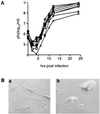Intergeneric poliovirus recombinants for the treatment of malignant glioma
- PMID: 10841575
- PMCID: PMC18745
- DOI: 10.1073/pnas.97.12.6803
Intergeneric poliovirus recombinants for the treatment of malignant glioma
Abstract
Poliovirus neuropathogenicity depends on sequences within the 5' nontranslated region of the virus. Exchange of the poliovirus internal ribosomal entry site with its counterpart from human rhinovirus type 2 resulted in attenuation of neurovirulence in primates. Despite deficient virus propagation in cells of neuronal origin, nonpathogenic polio recombinants retain excellent growth characteristics in cell lines derived from glial neoplasms. Susceptibility of malignant glioma cells to poliovirus may be mediated by expression of a poliovirus receptor, CD155, in glial neoplasms. Intergeneric polio recombinants with heterologous internal ribosomal entry site elements unfolded strong oncolytic potential against experimentally induced gliomas in athymic mice. Our observations suggest that highly attenuated poliovirus recombinants may have applicability as biotherapeutic antineoplastic agents.
Figures






Comment on
-
Glioblastoma multiforme: the terminator.Proc Natl Acad Sci U S A. 2000 Jun 6;97(12):6242-4. doi: 10.1073/pnas.97.12.6242. Proc Natl Acad Sci U S A. 2000. PMID: 10841526 Free PMC article. No abstract available.
References
-
- Levin V A, Gutin P H, Leibel S. In: Cancer: Principles & Practice of Oncology. DeVita V, Hellman S, Rosenberg S A, editors. Philadelphia: Lippincott; 1993. pp. 1679–1737.
-
- Martuza R L, Malick A, Markert J M, Ruffner K L, Coen D M. Science. 1991;252:854–856. - PubMed
-
- Coffey M C, Strong J E, Forsyth P A, Lee P W K. Science. 1998;282:1332–1334. - PubMed
-
- Culver K W, Ram Z, Wallbridge S, Ishii H, Oldfield E H, Blaese R M. Science. 1992;256:1550–1552. - PubMed
-
- Eck S L, Alavi J B, Alavi A, Davis A, Hackney D, Judy M, Mollman J, Phillips P C, Wheeldon E B, Wilson J M. Hum Gene Ther. 1996;7:1465–1482. - PubMed
Publication types
MeSH terms
Substances
LinkOut - more resources
Full Text Sources
Other Literature Sources
Molecular Biology Databases
Research Materials

